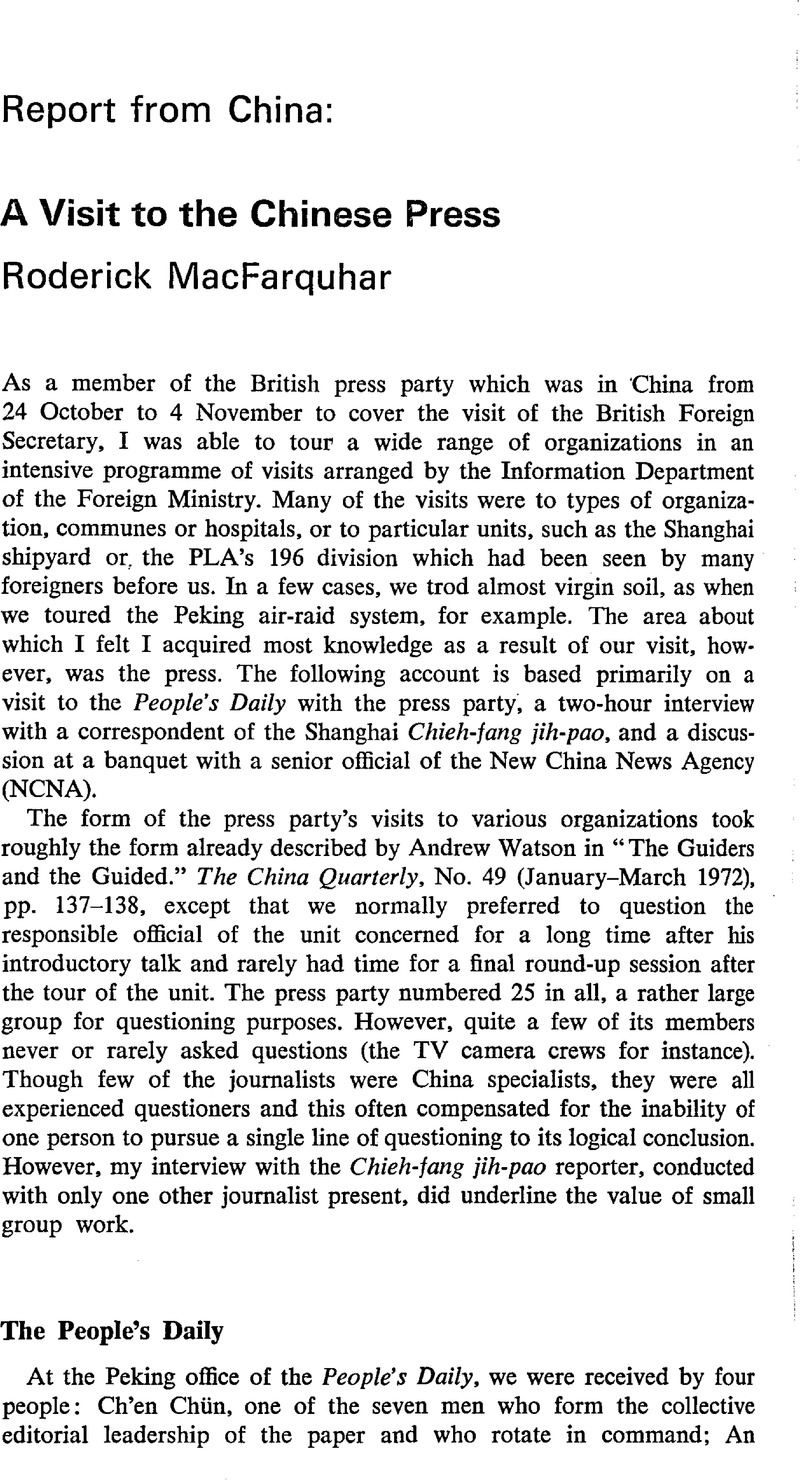Published online by Cambridge University Press: 30 September 2019

* A French correspondent was recently told that the paper had 400 on its editorial staff; see Alain Bouc, “Visite au Quotidien du Peuple,” Le Monde, 13 December 1972.
1. We were told that one reason why local papers were not available to foreigners was that they were not always able successfully to put over the Party line.
2. Cuttings are only made from Chinese sources, though some foreign newspapers, mainly English, but also French and Japanese, are filed. However, the People's Daily does not subscribe to many foreign papers; that is left to the NCNA.
3. There appears to be a three-year rotation system in operation; one year at the May 7th school, the next year at the grass roots and the next in Peking.
4. The People's Daily used to have its own correspondents stationed throughout China. These, we were told, were withdrawn in October 1957 as part of a move to end re-duplication of effort within the NCNA; an additional reason may have been Mao Tse-tung's dissatisfaction with the role of the People's Daily earlier in the year, dissatisfaction which was certainly the reason for the replacement of Teng T'o as editor in the summer of that year. However, since it was the then Director of the NCNA, Wu Leng-hsi, who replaced Teng T'o, the measure may have also been motivated by a desire to reassert the primacy of the NCNA in the news gathering field. Today, correspondents are responsible to the dual leadership of the NCNA and the People's Daily and may write special features for the paper; but all news is released via the NCNA. The paper does have its own correspondent in Japan and there will be another when the paper again posts a man in London in exchange for The Times man in Peking. Consideration is also being given to the posting of other foreign correspondents.
5. Recently, the paper has started transmitting facsimiles to Urumchi, Chengtu, and Canton; it is hoped to adopt this process for the other six cities as well.
** On 1 July 1957, the People's Daily and five other newspapers came to an agreement with the NCNA and the Peking Post Office in an attempt to publish earlier. The NCNA undertook to get all items to the papers by 12.30 a.m. so that they could go to press by 4 a.m. It was hoped that readers in central Peking would be able to read their papers at about 8 a.m. (see Survey of the China Mainland Press, No. 1580, p. 8.). Now, most officials in Peking, so I was told, read the Peking Daily at home in the morning and the People's Daily when they get to the office.
*** Alain Bouc was told that a compositor can assemble 2,000 characters per hour, that the basic vocabulary consisted of 3,000 characters and the total vocabulary of 7,000; Le Monde, 13 December.
6. There are, of course, occasional special editions (fell had) dealing with special news items such as successful nuclear tests.
7. The figure of 30 million does not include the 6 million copies of Ts'an-k'ao hsiao-hsi (Reference News) printed every day by the NCNA. Ts'an-k'ao hsiaohsi, which prints items like translated foreign news agency reports, is not sold publicly, but is distributed to departments for responsible cadres to see. One gathers that it is not too difficult for officials of fairly low-rank to get permission to read it; in the Peking Hotel, it was read openly by clerks behind the desks of the postal and banking departments. Copies of the fuller and apparently more restricted Ts'an-k'ao tzu-liao (Reference Material) were visible on the desks of people in the People's Daily office. (See also Henry G. Schwartz, “ The Ts'ank'ao hsiao-hsi: How well informed are Chinese officials about the outside world?” The China Quarterly, No. 27 (July-September 1966), pp. 54-83.)
8. Unlike western papers, the People's Daily derives only a tiny proportion of its income from advertising. The only kind of advertising accepted is for important new books, operas, or films (at 7 yuan a square inch), or for the Canton trade fair (paid for by the Ministry of Foreign Trade at 35 yuan a square inch).
9. Our informant did not know who, other than Chairman Mao and Premier Chou, might be in the top cadre grade.
10. The three papers normally publish editorials jointly on major occasions.
11. Asked why the People's Daily had published no editorials on the occasion of International Women's Day since the Cultural Revolution, Mr Ch'en smiled and said they opposed ritualism and “ What was there new to say? “
12. We were told on another occasion that all Party branches which had been in existence before the Cultural Revolution had been re-established. The 20-million figure is higher than the last known pre-Cultural Revolution total, 17 million in mid-1961.
13. She thought that Wang Ching, the Editor, earned about 100 yuan per month.
14. The People's Daily has no women among its top seven. Mr. Ch'en explained this by pointing out that the paper's senior men had entered journalism at a time when relatively few women were educated.
15. For further information on the NCNA, based partly on material supplied by a former correspondent, see Alan P. L. Liu, “ Ideology and information; correspondents of the New China News Agency and Chinese foreign policy making,” Journal of International Affairs, No. 2, 1972, pp. 131-45.